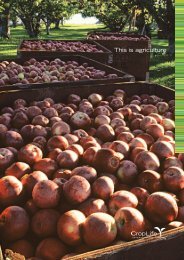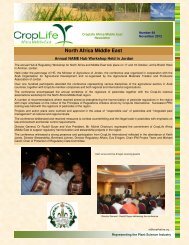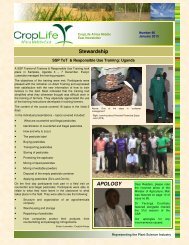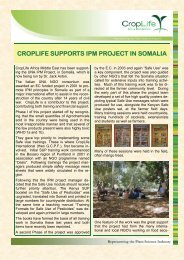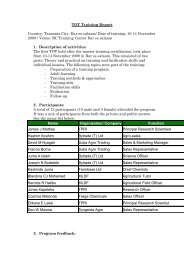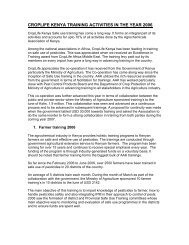Newsletter April 2013 - CropLife Africa Middle East
Newsletter April 2013 - CropLife Africa Middle East
Newsletter April 2013 - CropLife Africa Middle East
Create successful ePaper yourself
Turn your PDF publications into a flip-book with our unique Google optimized e-Paper software.
Page 14<br />
<strong>CropLife</strong> <strong>Africa</strong> <strong>Middle</strong> <strong>East</strong> <strong>Newsletter</strong> Number 89<br />
<strong>April</strong> <strong>2013</strong><br />
TOP TEN FACTS about Biotech/GM Crops in 2012<br />
FACT # 1. 2012 was the 17th year of successful commercialization of biotech crops. Biotech crops were first commercialized in<br />
1996. Hectarage of biotech crops increased every single year between 1996 to 2012 with 12 years of double digit growth rates,<br />
reflecting the confidence and trust of millions of risk-averse farmers around the world, in both developing and industrial<br />
countries. <br />
FACT # 2. Biotech crop hectares increased by an unprecedented 100–fold from 1.7 million hectares in 1996, to over 170 million<br />
hectares in 2012. This makes biotech crops the fastest adopted crop technology in recent times – the reason – they deliver<br />
benefits. In 2012, hectarage of biotech crops grew at an annual growth rate of 6%, up 10.3 million from 160 million hectares in <br />
2011. Millions of farmers in ~30 countries worldwide, have made more than 100 million independent decisions to plant an<br />
accumulated hectarage of ~1.5 billion hectares, equivalent to 50% more than the total land mass of the US or China; this<br />
reflects the fact that biotech crops deliver sustainable and substantial, socioeconomic and environmental benefits. <br />
FACT # 3. For the first time in 2012, developing countries planted more hectares than industrial countries. Notably, developing<br />
countries grew more, 52%, of global biotech crops in 2012 than industrial countries at 48%. In 2012, growth rate for biotech<br />
crops was at least three times as fast, and five times as large in developing countries, at 11% or 8.7 million hectares, versus 3%<br />
or 1.6 million hectares in industrial countries. <br />
FACT # 4. Number of countries growing biotech crops. Of the 28 countries, which planted biotech crops in 2012, 20 were<br />
developing and 8 were industrial countries; two new countries, Sudan (Bt cotton) and Cuba (Bt maize) planted biotech crops for<br />
the first time in 2012. Germany and Sweden could not plant the biotech potato "Amflora" because it ceased to be marketed.<br />
Stacked traits are an important feature – 13 countries planted biotech crops with two or more traits in 2012, and notably, 10 of<br />
the 13 were developing countries – 43.7 million hectares, or more than a quarter, of the 170 million hectares were stacked in<br />
2012. <br />
FACT # 5. Number of farmers growing biotech crops. In 2012, a record 17.3 million farmers, up 0.6 million from 2011, grew<br />
biotech crops – remarkably over 90%, or over 15 million, were small resource-poor farmers in developing countries. Farmers<br />
are the masters of risk-aversion and in 2012, a record 7.2 million small farmers in China and another 7.2 million in India, elected<br />
to plant almost 15 million hectares of Bt cotton, because of the significant benefits it offers. In 2012 over one-third of a million<br />
small farmers in the Philippines benefited from biotech maize. <br />
FACT # 6. The top 5 countries planting biotech crops. The US continued to be the lead country with 69.5 million hectares, with<br />
an average ~ 90% adoption across all crops. Brazil was ranked second, and for the fourth consecutive year, was the engine of<br />
growth globally, increasing its hectarage of biotech crops more than any other country – an impressive record increase of 6.3<br />
million hectares, up 21% from 2011, reaching 36.6 million hectares. Argentina retained its third place with 23.9 million hectares.<br />
Canada was fourth at 11.8 million hectares with 8.4 million hectares of canola at a record 97.5% adoption. India was fifth,<br />
growing a record 10.8 million hectares of Bt cotton with an adoption rate of 93%. In 2012, each of the top 10 countries planted<br />
more than 1 million hectares providing a broad foundation for future growth <br />
FACT # 7. Status of biotech crops in <strong>Africa</strong>. The continent continued to make progress with South <strong>Africa</strong> increasing its biotech<br />
area by a record 0.6 million hectares to reach 2.9 million hectares; Sudan joined South <strong>Africa</strong>, Burkina Faso and Egypt, to bring<br />
the total number of <strong>Africa</strong>n biotech countries commercializing biotech crops to four. Five countries, Cameroon, Kenya, Malawi,<br />
Nigeria and Uganda conducted field trials of biotech crops, the penultimate step prior to approval for commercialization. The<br />
lack of appropriate, science-based and cost/time-effective regulatory systems continue to be the major constraint to adoption.<br />
Responsible, rigorous but not onerous, regulation is needed, particularly for small and poor developing countries. <br />
FACT # 8. Status of biotech crops in the EU. Five EU countries, (Spain, Portugal, Czechia, Romania and Slovakia) planted a<br />
record 129,071 hectares of biotech Bt maize, up 13% from 2011. Spain led the EU with 116,307 hectares of Bt maize, up 20%<br />
from 2011 with a record 30% adoption rate in 2012. <br />
FACT # 9. Benefits offered by biotech crops. From 1996 to 2011, biotech crops contributed to Food Security, Sustainability and<br />
the Environment/Climate Change by: increasing crop production valued at US$98.2 billion; providing a better environment, by<br />
saving 473 million kg a.i. of pesticides; in 2011 alone reducing CO2 emissions by 23.1 billion kg, equivalent to taking 10.2<br />
million cars off the road for one year; conserving biodiversity by saving 108.7 million hectares of land; and helped alleviate<br />
poverty for >15.0 million small farmers and their families totaling >50 million people, who are some of the poorest people in the<br />
world. Biotech crops are essential but are not a panacea and adherence to good farming practices such as rotations and<br />
resistance management, are a must for biotech crops as they are for conventional crops. <br />
FACT # 10. Future Prospects. Cautiously optimistic with more modest annual gains likely due to the already high rates of<br />
adoption in the principal biotech crops in mature markets in both developing and industrial countries. <br />
Clive James, ISAAA<br />
Representing the Plant Science Industry






